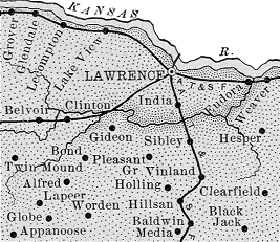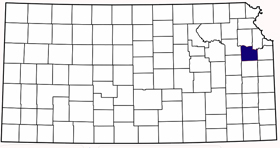 1889 Map
1889 Map

 1889 Map
1889 Map

Located in northeast Kansas, Douglas County was one
of the original 33 counties created by the First Territorial Legislature in
July, 1855. The county was named in honor of Stephen A. Douglas, a United States
Senator from Illinois who had supported the Kansas-Nebraska Act in 1854.
Before the area was opened to white settlement on May
15, 1854, the region was held by the Shawnee Indians as part of their
reservation under a treaty that had been made in 1825. This treaty allotted the
Shawnee some 200,000 acres, most in adjacent Johnson County, but, also embraced
much of the land in Eudora Township, in the northeastern part of Douglas County.
As soon as the territory was thrown open to settlement, "squatters" ignored the
treaty with the Shawnee, arriving from Missouri and other states to secure
claims, as the region had been long known as a desirable location.
These; however, were not the first white men in what
would become Douglas County. In June, 1842, General John Charles Fremont, on his
first exploratory tour to the Rocky Mountains, traveled from Cyprian Chouteaus's
trading post on the Kansas River, six miles west of the Missouri line, and
encamped near the present location of Lawrence. He described it as follows:
"We encamped in a remarkable beautiful situation on
the Kansas bluffs, which commanded a fine view of the river valley, here from
four to five miles wide. The central portion was occupied by a broad belt of
heavy timber, and nearer the hills prairies were of the richest verdure
[vegetation.]"
Lawrence Kansas in 1854The first permanent white
settlement in what is now Douglas County was made by Frederick Chouteau in 1827,
when he established a trading post, on the south bank of the Kansas River, a
little above the what would become the settlement of Lake View. However, he
remained only a short time, moving to what would become Shawnee County in 1830.
In 1848 the Methodist Episcopal Church established a mission among the Shawnee
on the south bank of the Kansas Rive, near the mouth of the Wakarusa, but in
1857 it was abandoned.
Many other California emigrants passing over this
route were particularly struck with the beauty of the scenery, and the
magnificence of the view in the vicinity of present-day Lawrence - among them
Dr. Charles Lawrence Robinson, who afterward became one of Douglas County’s
pioneer settlers and most honored citizens.
When the area officially opened for settlement in May,
1854, hundreds of emigrants flocked to the region in efforts to make Kansas
either a free or a slave state. The abolitionists primarily settled in Douglas
County and soon, Lawrence would become the center of the conflict nicknamed
Bleeding Kansas.
Most of the claims taken by the Missourians were
merely staked out, or a few logs cut and piled up crosswise to show occupation,
sometimes only a notice was posted. Of these non-resident squatters, nearly all
returned to Missouri, but they had organized and agreed to have no interference
with their "paper" claims, threatening to shoot any man who attempted to take
possession.
But the most systematic movement toward colonization
was made by the New England Emigrant Aid Company which directed a party of men
from Massachusetts and Vermont to start for Kansas with a view of establishing
permanent settlements and working to make Kansas a Free-State. Other companies
followed and together they founded the city of Lawrence.
When claims were taken by squatters, it was assumed
that they had secured the land for a permanent home and intended to improve
them, but as many did not do this the early settlers formed associations to
protect themselves against such encroachment upon the land. Before the New
England emigrants came to the territory two such organizations had been formed
in what would become Douglas County. A call was issued for a meeting to be held
on July 8, 1854, at Blue Jacket's store on the Wakarusa River. The Free State
men who had already located in the vicinity believed that the meeting was to be
of men friendly to making Kansas a Free State and attended in considerable
numbers, but upon their arrival, discovered that it was a meeting of squatters
to make rules and regulations with regard to their claims. A number of those
present were pro-slavery in sentiment and wished to introduce resolutions
barring emigrants opposed to the institution of slavery; however, there were too
many Free State men present to carry out their plan, and a compromise was
effected by which any person had a right to bring property into the state and
the question of slavery was to be settled when the territory had a sufficient
population to be admitted to statehood. Some of the more bitter pro-slavery men
were not satisfied with the turn of affairs and openly declared that they
intended to fight the settling of the territory by Free State men, especially
the New England Company. This first organization was known as the Wakarusa
Association.
Baldwin City
Big Springs
Clinton
Eudora
Lawrence
Lecompton
Vinland
I have all of these books and will look up information for you. Email me if you think your ancestors are listed in these books!
The KSGenWeb logo is copyrighted for the exclusive use of the KSGenWeb Project for display on official KSGenWeb Pages only. Unauthorized use of the contents of this page for profit/commercial ventures is expressly prohibited.
 |
 |
 |